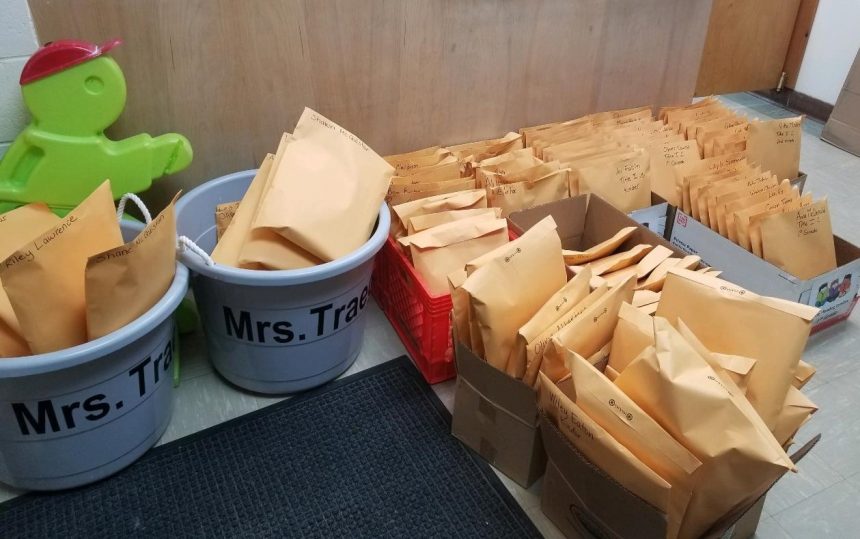Scio educators restart school, with plan to learn as they go
Fourth grade teacher Roby Reeder held his first class in more than two weeks Wednesday.
Unleashed by Monday’s Oregon Department of Education guidance, the Scio School District is back to offering new lessons, not just “supplemental learning.”
Assignments popped into Google Classroom for Reeder’s Centennial Elementary students at 9 a.m. Nine of his 30 students showed up for a Google Meet soon after.
“They were pretty excited to see me and each other,” Reeder said. He told them, “If you guys would like to learn, I would like to teach you.”
Reeder checked in with students by phone as well. By midday, more than half the students had turned in assignments.
Gov. Kate Brown’s March 17 order said schools must offer educational opportunities while remaining closed. ODE huddled with education stakeholders, including OSBA, and scrambled to define what schools could do. Its Distance Learning for All plan told schools to start moving classes forward again by April 13.
The district southeast of Salem was raring to go. Scio’s plans for education during a worldwide pandemic include some technology steps already taken and a whole lot of steps into the unknown.
“We’re to the messy part,” said Scio Superintendent Gary Tempel.
Classified staff have been calling parents to see what they need, starting with essentials such as food, child care and mental health support and moving on to issues such as internet connectivity.
Scio has about 650 students. By last week, the district was delivering nearly 500 meals a day, two per delivery. The school district bought plastic bins to put on porches for deliveries of food and school supplies and to pick up homework. The bins included instructions not to bring them inside and not to come out to meet people making deliveries.
Scio Mutual Telephone Association is installing internet for free to families, and the school district is paying for the internet. Tempel traveled to area cities to rustle up Wi-Fi hot spots for students.
“When we started figuring out we needed hot spots, the world was sold out,” Tempel said.
The district was already close to being one-to-one with Chromebooks. Scio bought 100 more Tuesday so everyone can have one.
“It’s going to be a rough three months, but there will be things that come out of this that we will all benefit from in our district,” he said.
The district is also supplying paper packets if parents want them. Tempel said some parents who requested packets have since changed their minds and asked for Chromebooks and internet connections.
The phone company set all staff members up with business phone numbers through the internet so they could communicate with students without using home phone numbers. Students can call the teachers directly if they need help.
Tempel paid teachers for two days during spring break for training and to develop learning plans. Some teachers were already using Google Classroom in the upper grades, but there is still a learning curve for teachers and students, especially K-3, for full online learning.
Centennial Elementary School Principal Kim Roth said her teachers are using Google Meet to read to young students and have them read back. They are using Google Classroom to give out assignments, and they are sending home art supplies and other materials so students can work on fine motor skills.
Roth told her teachers to start slow and easy so that children new to the technology can have success from the beginning. Parents are nervous, too, about becoming their child’s assistant teacher.
Lessons are flexible, with recorded instructions and activities students can do independently. Teachers are available by phone in the evenings.
Teachers are helping each other and looking for creative solutions. Roth said they need to allow themselves not to have it perfect at the beginning.
“I think we are going to come out to some incredible teaching strategies that we haven’t used before,” she said.
Teacher aides have also been learning the technology so they can help students. Classified staff have been assigned caseloads of students needing academic support for individualized education programs. They are checking in to make sure the students can access the curriculum, offering help and guiding the students to advocate for themselves. The district has sent home special learning tools students might need.
Tempel said they have a plan to reach everyone but they’re not sure if they can give everyone everything they need. Specialists are also developing plans to deliver make-up services later to students who can’t get full services right now.
Scio has identified students who although not on a learning plan, still might need some extra help. Some classified staff whose duties have disappeared are being reassigned to check on those students.
Classified staff are under enormous strain right now. Some, such as drivers and food service workers, are nearly overwhelmed while others are being trained for unfamiliar roles.
Scio High School librarian Diana Cox, Scio’s Oregon School Employees Association chapter president, said that everybody wants to help in any way they can.
She encouraged people not to “get hung up on time cards.” She said the pay is already in the budget and many hourly workers are remaining on call around the clock to be an ear for students, check on student welfare and help with assignments.
It’s been an expensive couple of weeks for Scio, and Tempel said he’s still looking for savings. Staff time remains the same, and they don’t know how much they might be reimbursed for meals or with other emergency relief.
School Board Chair Doug Parazoo said the budget is always in the back of school board members’ minds but they have to push forward to make sure students and employees have what they need.
He commended staff for going “above and beyond.”
The schools won’t be able to replace everything that went on in a day, but teachers are looking at core skills and what it will take to get to proficiency.

